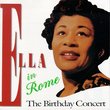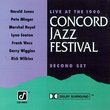| All Artists: Don Ellis Title: Live at Monterey Members Wishing: 0 Total Copies: 0 Label: Blue Note Records Original Release Date: 1/1/1966 Re-Release Date: 7/28/1998 Album Type: Live Genres: Jazz, Pop Styles: Avant Garde & Free Jazz, Modern Postbebop, Swing Jazz, Bebop Number of Discs: 1 SwapaCD Credits: 1 UPCs: 724349476820, 0724349476851, 724349476851 |
Search - Don Ellis :: Live at Monterey
 | Don Ellis Live at Monterey Genres: Jazz, Pop
|
Larger Image |
CD DetailsSimilarly Requested CDs |
CD ReviewsSurprisingly accessible and exciting music Gerhard Auer | Leoben, Steiermark Austria | 01/16/2000 (5 out of 5 stars) "If you ever tried to find a melody that fits seamlessly into a meter like 19/8 or 27/16 without sounding forced or predictable, you know how difficult this is to manage. Fluent improvisation in such a complex rhythmic context is, of course, an even harder task. Similar (and, mostly, less complex) experiments by other artists have sounded pretty acedemic; but that's not that kind of 'Well, let's try some new strange meter and see what comes out' stuff - and no 'difficult' or forbidding music, either. The main difference to some less successful records in a similar vein is that the Don Ellis Orchestra SWINGS LIKE HELL! Ellis's quarter tone trumpet in particular dances completely naturally above some of the oddest rhythmic structures you'll ever hear (without being polyrhythmic or free) - something that's quite common in some Eastern music cultures but has rarely been done in Jazz, at least not in such a fully convincing and stimulating way. Emotional highlights of the CD are 33 222 1 222 (the title describes the meter of the track - pretty tricky foot tapping... NB: This piece is not listed above, but it's on the CD!) and the previously unreleased 'Beat Me Daddy, 7 To The Bar', a boogie in 7/8 time. - If you ever considered Dave Brubeck's Time Out, Time Further Out and Time Even A Bit More Out albums (you get the idea) a shade too tame and cool - here's the real thing!" Waiting for "Tears Of Joy" on CD, but this is good Gunnar Wiskoff | Seattle, WA United States | 01/25/2003 (5 out of 5 stars) "I got Live at Monterey in my CD collection so I could hopefully scratch a Don Ellis itch that I've been having. Unfortunately, I really need to hear "Tears Of Joy" on CD to really get relief. I have it on vinyl, but it doesn't do a bit of justice to the softer parts, as I hear the needle running through the groove better than I can hear the string quartet."Tears Of Joy" really needs to be released onto CD! It's a phenomenal live recording, and it's just not my opinion that it's Ellis' best work. Look on the web. Do a search on "Tears Of Joy" and you'll get sites that say "my personal favorite" and other similar statements. Then tell Koch Jazz to get busy on getting it out!!" Where it all began pjimmy | Poway, CA USA | 04/21/2006 (5 out of 5 stars) "This album has great insight as to how Ellis and his band could capture an audience.
In the introduction by Jimmy Lyons, you can hear the smattering of courtesy applause from an audience that had no idea of what was about to happen. After the end of the first selection "33 222 1 222", it was clear that the crowd realized they were witnessing something amazing. By the end of the performance, based on the reaction of the crowd, he not only had the audience hooked, he had 'em landed, cleaned, filleted and fried! "Concerto for Trumpet" is my favorite selection because I had the chance to hear Don perform it live. It's the piece that got me and the audience "hooked" in 1969. He was an absolute genius at his craft. Imagine what he could have done with another 20 years? " |

 Track Listings (8) - Disc #1
Track Listings (8) - Disc #1



